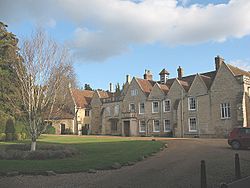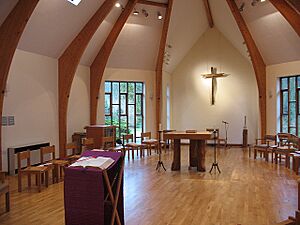Turvey Abbey facts for kids
 |
|
| Monastery information | |
|---|---|
| Full name | Priory of Our Lady of Peace |
| Order | Benedictine |
| Established | 1980 |
| Site | |
| Location | Turvey, Bedfordshire, England |
| Coordinates | 52°09′42″N 0°37′06″W / 52.16163°N 0.6182°W |
Turvey Abbey is a historic building located in the small village of Turvey in England. It is found in the county of Bedfordshire. The building has dates carved into its stone walls: 1605 on the front (north side) and 1608 on the back (south side). It is made of stone with a tile roof.
There is also an old dovecote nearby, which is a special building where pigeons used to be kept. This dovecote is a very old and important building, but it does not belong to Turvey Abbey anymore.
Contents
Who Lives There Now?
Today, Turvey Abbey is home to a group of nuns called the "Priory of Our Lady of Peace". These nuns are part of the Benedictine order, which is a very old Christian group. They follow a special way of life called the Rule of Saint Benedict. This rule helps them live together in peace and prayer.
The nuns at Turvey Abbey are connected to the Olivetan family of Benedictines. While the Abbey is not open for everyone to visit, the nuns do welcome guests who want to spend time in quiet reflection or prayer.
Right next to Turvey Abbey is another religious community called the "Monastery of Christ our Saviour". It is important to know that this monastery is a separate place and not part of Turvey Abbey itself.
A Look Back in Time: The History of Turvey Abbey
The oldest part of Turvey Abbey was built in 1603. Some records even suggest that parts of the building might be even older than that!
The Brand Family
For a long time, a family named Brand lived in the house. Thomas Brand (who passed away in 1694) and his wife Margaret (who passed away in 1718) moved into the house around 1670. They were Catholic recusants, which means they were Catholics who did not follow the official Church of England at that time. They are mentioned in many old records.
The Laurence Family
Later, in 1750, William Laurence and Sarah Steward got married in Bedford. They had six children. One of their children, Thomas Laurence, became a churchwarden, which is a person who helps manage a church. William Laurence passed away in 1766 when his children were still very young. He made sure to leave money and property for his family in his will.
The Higgins Family and Changes to the Abbey
In 1786, another family, the Mordants, sold their land in Turvey. An advertisement for the sale mentioned Sarah Laurence as the person renting the farm that included "The Abbey." A very rich merchant from London named Charles Higgins bought the property. He used it as his country home. He allowed Sarah Laurence to keep living there by dividing the house and garden into two parts. Charles Higgins also made many important repairs to the building at this time. When he passed away in 1792, his nephew, John Higgins, inherited the house.
John Higgins (1768–1846) loved "The Abbey" very much. Even before he owned it, he often visited Turvey to see the house. He wrote about these visits in his personal memoirs. He said that he first saw Turvey Abbey in 1781 and was very interested in it, even though he only knew it was a farm called "The Abbey."
A few years later, he went fishing with friends. While they were relaxing, he quickly went to look at the old house and explored as much of the outside as he could. He even drew pictures of the front and back of the house, which he kept in his memoirs.
Around 1801, John Higgins added more parts to the house. He built a new coach house with a clock, which is now called Brand House. He also added decorative railings and two special windows that he brought from another place called Easton Maudit. Later, he built a walled garden and a pretty summer house in a Gothic style.
See also


